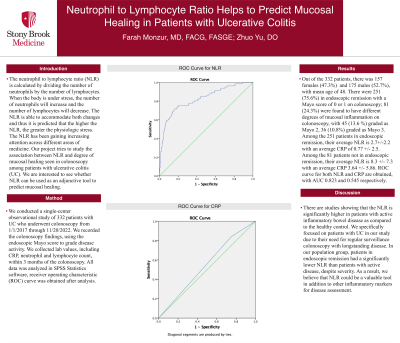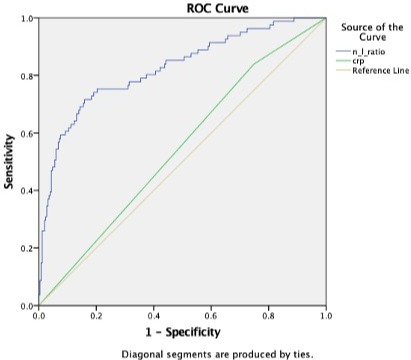Sunday Poster Session
Category: IBD
P0750 - Neutrophil to Lymphocyte Ratio Helps to Predict Mucosal Healing in Patients With Ulcerative Colitis
Sunday, October 22, 2023
3:30 PM - 7:00 PM PT
Location: Exhibit Hall

Has Audio

Zhuo Yu, DO
Stony Brook University Hospital
Stony Brook, NY
Presenting Author(s)
Zhuo Yu, DO, Farah Monzur, MD, FACG
Stony Brook University Hospital, Stony Brook, NY
Introduction: The neutrophil to lymphocyte ratio (NLR) is calculated by dividing the number of neutrophils by the number of lymphocytes. When the body is under stress, the number of neutrophils will increase and the number of lymphocytes will decrease. The NLR is able to accommodate both changes and thus it is predicted that the higher the NLR, the greater the physiologic stress. The NLR has been gaining increasing attention across different areas of medicine. Our project tries to study the association between the NLR and degree of mucosal healing seen in colonoscopy among patients with ulcerative colitis (UC). We are interested to see whether the NLR could be used as an adjunctive tool to predict mucosal healing.
Methods: We conducted a single-center observational study of 332 patients with UC who underwent colonoscopy from 1/1/2017 through 11/20/2022. We recorded the colonoscopy findings, using the endoscopic Mayo score to grade disease activity. We collected lab values, including CRP, neutrophil and lymphocyte count, within 3 months of the colonoscopy. All data was analyzed in SPSS Statistics software. Receiver operating characteristic (ROC) curve was obtained after analysis.
Results: Out of 332 patients, there were 157 females (47.3%) and 175 males (52.7%), with a mean age of 48. There were 251 patients (75.6%) in endoscopic remission with a Mayo score of 0 or 1 on colonoscopy; 81 (24.4%) were found to have different degrees of mucosal inflammation on colonoscopy, with 45 (13.6 %) graded as Mayo 2 and 36 (10.8%) graded as Mayo 3. Among the 251 patients in endoscopic remission, their average NLR is 2.7+/-2.2 with an average CRP of 0.77 +/- 2.5. Among the 81 patients not in endoscopic remission, their average NLR is 8.3 +/- 7.3 (P< 0.0001) with an average CRP 3.64 +/- 5.86 (P< 0.0001). ROC curve for both NLR and CRP are obtained, with area under curve (AUC) 0.823 and 0.545 respectively.
Discussion: There are studies showing that the NLR is significantly higher in patients with active inflammatory bowel disease as compared to healthy controls. We specifically focused on patients with UC in our study due to their need for regular surveillance colonoscopies with longstanding disease. In our population group, patients in endoscopic remission had a significantly lower NLR than patients with active disease. As a result, we believe that NLR could be a valuable tool in addition to other inflammatory markers for disease assessment.

Disclosures:
Zhuo Yu, DO, Farah Monzur, MD, FACG. P0750 - Neutrophil to Lymphocyte Ratio Helps to Predict Mucosal Healing in Patients With Ulcerative Colitis, ACG 2023 Annual Scientific Meeting Abstracts. Vancouver, BC, Canada: American College of Gastroenterology.
Stony Brook University Hospital, Stony Brook, NY
Introduction: The neutrophil to lymphocyte ratio (NLR) is calculated by dividing the number of neutrophils by the number of lymphocytes. When the body is under stress, the number of neutrophils will increase and the number of lymphocytes will decrease. The NLR is able to accommodate both changes and thus it is predicted that the higher the NLR, the greater the physiologic stress. The NLR has been gaining increasing attention across different areas of medicine. Our project tries to study the association between the NLR and degree of mucosal healing seen in colonoscopy among patients with ulcerative colitis (UC). We are interested to see whether the NLR could be used as an adjunctive tool to predict mucosal healing.
Methods: We conducted a single-center observational study of 332 patients with UC who underwent colonoscopy from 1/1/2017 through 11/20/2022. We recorded the colonoscopy findings, using the endoscopic Mayo score to grade disease activity. We collected lab values, including CRP, neutrophil and lymphocyte count, within 3 months of the colonoscopy. All data was analyzed in SPSS Statistics software. Receiver operating characteristic (ROC) curve was obtained after analysis.
Results: Out of 332 patients, there were 157 females (47.3%) and 175 males (52.7%), with a mean age of 48. There were 251 patients (75.6%) in endoscopic remission with a Mayo score of 0 or 1 on colonoscopy; 81 (24.4%) were found to have different degrees of mucosal inflammation on colonoscopy, with 45 (13.6 %) graded as Mayo 2 and 36 (10.8%) graded as Mayo 3. Among the 251 patients in endoscopic remission, their average NLR is 2.7+/-2.2 with an average CRP of 0.77 +/- 2.5. Among the 81 patients not in endoscopic remission, their average NLR is 8.3 +/- 7.3 (P< 0.0001) with an average CRP 3.64 +/- 5.86 (P< 0.0001). ROC curve for both NLR and CRP are obtained, with area under curve (AUC) 0.823 and 0.545 respectively.
Discussion: There are studies showing that the NLR is significantly higher in patients with active inflammatory bowel disease as compared to healthy controls. We specifically focused on patients with UC in our study due to their need for regular surveillance colonoscopies with longstanding disease. In our population group, patients in endoscopic remission had a significantly lower NLR than patients with active disease. As a result, we believe that NLR could be a valuable tool in addition to other inflammatory markers for disease assessment.

Figure: This graph shows the ROC curve for both NLR and CRP in patients diagnosed with Ulcerative Colitis who underwent surveillance colonoscopy for disease assessment,
Disclosures:
Zhuo Yu indicated no relevant financial relationships.
Farah Monzur: Medtronic (Covidien) – Consultant.
Zhuo Yu, DO, Farah Monzur, MD, FACG. P0750 - Neutrophil to Lymphocyte Ratio Helps to Predict Mucosal Healing in Patients With Ulcerative Colitis, ACG 2023 Annual Scientific Meeting Abstracts. Vancouver, BC, Canada: American College of Gastroenterology.
